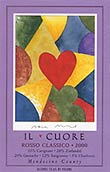 |
|
Wine Details
Price:
$12.00 per bottle
Description:
Rosso Classico creates a rich and exuberant expression of berries, plums and ripe cherries. Sangiovese, the principle grape
variety of Chianti, contributes effusive ripe cherry flavors and good acidity to cut through spicy cuisine. Old Vine Carignane offers deep fruit flavors and structure while Zinfandel from this region provides jammy complexity and spicy character. Syrah from old plantings adds succulent plum nuances and great color. The fruity, spicy flavor will enhance a diverse range of cuisine, including comfort foods such as braised lamb shanks, roasted herbed chicken, classic Italian dishes and especially Mediterranean style grilled meats. Rosso Classico is excellent served with oven-roasted salmon, grilled eggplant, and has the fresh acidity to marry with spicy cuisine and dishes with tons of garlic!
|
|
|